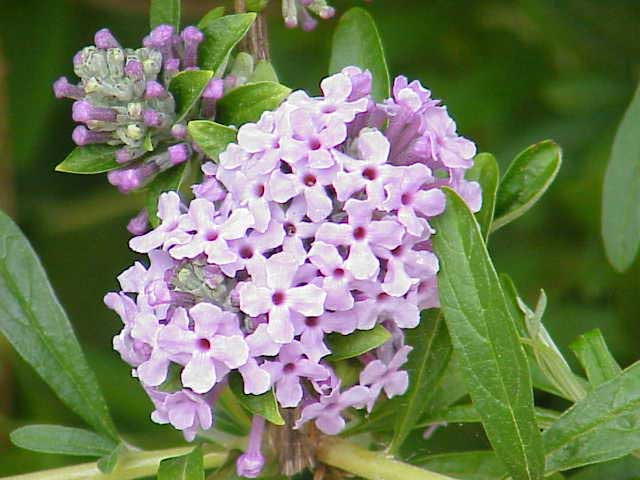
Buddleja alternifolia (*)
Classification System: APG IV
Superregnum: Eukaryota
Regnum: Plantae
Cladus: Angiosperms
Cladus: Eudicots
Cladus: Core eudicots
Cladus: Asterids
Cladus: Lamiids
Ordo: Lamiales
Familia: Scrophulariaceae
Tribus: Buddlejeae
Genus: Buddleja
Sectio: Buddleja sect. Alternifoliae
Species: Buddleja alternifolia
Name
Buddleja alternifolia Maxim.
Hybrids
B. × pikei – B. × whiteana
References
Bull. Acad. Imp. Sci. Saint-Pétersbourg 26:494; Mélanges Biol. Bull. Phys.-Math. Acad. Imp. Sci. Saint-Pétersbourg 10:673. 1880 (Diagn. pl. nov. asiat.)
USDA, ARS, Germplasm Resources Information Network. Buddleja alternifolia in the Germplasm Resources Information Network (GRIN), U.S. Department of Agriculture Agricultural Research Service. Accessed: 07-Oct-06.
Buddleja alternifolia, known as alternate-leaved butterfly-bush,[1] is a species of flowering plant in the figwort family, which is endemic to Gansu, China. A substantial deciduous shrub growing to 4 metres (13 ft) tall and wide, it bears grey-green leaves and graceful pendent racemes of scented lilac flowers in summer.
Description
Inflorescence
B. alternifolia is a vigorous deciduous shrub reaching 5 m (16 ft) tall with long, slender, pendulous stems. The leaves are alternate, entire, and lanceolate, 4–10 cm long by 0.6–1 cm wide, glabrous and dark green above. The inflorescences of the plants in cultivation are bright lilac-purple, and comprise flowers so densely crowded in clusters along the branch as to often obscure it. However, specimens from the Tsangpo valley in Tibet originally named B. tsetangensis by Marquand have creamy flowers. Flowering occurs in early summer; the flowers are fragrant, but less so than other buddlejas.[2] 2n = 38.[3]
In its native territory it grows along river banks in thickets at elevations of 1,500–4,000 m (4,900–13,100 ft).
Taxonomy
In his 1979 revision of the taxonomy of the African and Asiatic species of Buddleja, the Dutch botanist Anthonius Leeuwenberg sank two species, B. legendrei and B. tsetangensis, as B. alternifolia on the basis of the similarity in the individual flowers, dismissing the variations in plant structure, flower colour and leaf as attributable to environmental factors.[4] It was Leeuwenberg's taxonomy which was adopted in the Flora of China[5] published in 1996. Until DNA analysis can prove otherwise, it is this classification which is accepted here.
Cultivation
In the West this plant was first described and named by the Russian botanist Carl Maximowicz[6] in 1880. It was not introduced to cultivation in the West until 1915, by Purdom and Farrer.[2] [4]
The species has become very common in cultivation, a popular shrub for the larger garden, and is readily available from most garden centres in the UK. Fully hardy, it prefers a sunny position and loamy soil; pruning should immediately follow flowering. Like most buddlejas, the species is easily propagated from cuttings.[2] Hardiness: RHS H5, USDA zones 7 – 9.[7]
B. alternifolia was accorded the Royal Horticultural Society's Award of Garden Merit (record 674) in 1993.[8][9]
Cultivars
Buddleja alternifolia ‘Argentea’.
References
BSBI List 2007 (xls). Botanical Society of Britain and Ireland. Archived from the original (xls) on 2015-06-26. Retrieved 2014-10-17.
Bean, W. J. (1917). Trees and shrubs hardy in Great Britain, 7th edition. Murray, London.
Chen, G, Sun, W-B, & Sun, H. (2007). Ploidy variation in Buddleja L. (Buddlejaceae) in the Sino - Himalayan region and its biogeographical implications. Botanical Journal of the Linnean Society. 2007, 154, 305 – 312. The Linnean Society of London.
Leeuwenberg, A. J. M. (1979) The Loganiaceae of Africa XVIII Buddleja L. II, Revision of the African & Asiatic species. H. Veenman & Zonen, Wageningen, Nederland.
Li, P-T. & Leeuwenberg, A. J. M. (1996). Loganiaceae, in Wu, Z. & Raven, P. (eds) Flora of China, Vol. 15. Science Press, Beijing, and Missouri Botanical Garden Press, St. Louis, USA. online at www.efloras.org
Maximowicz, (1880). Bull. Acad. Pétersb. xxvi. 494. 1880.
Stuart, D. D. (2006). Buddlejas. RHS Plant Collector Guide. Timber Press, Oregon. ISBN 978-0-88192-688-0.
"RHS Plant Selector - Buddleja alternifolia". Retrieved 15 April 2020.
"RHS AGM Listing May 2013 (Ornamentals)". Archived from the original on 8 June 2013. Retrieved 18 June 2013.
Hillier & Sons. (1977). Hilliers' Manual of Trees and Shrubs. David & Charles, Newton Abbot, UK
Retrieved from "http://en.wikipedia.org/"
All text is available under the terms of the GNU Free Documentation License

